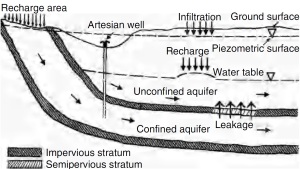INTRODUCTION
Groundwater plays a major role in augmenting water supply to meet the ever-increasing domestic, agricultural, and industrial demands. Increasing dependence of water supply on groundwater resources is resulting in increasing use of aquifers as a source of fresh water supply and subsurface reservoir for storing excess surface water. Aquifers are the geological formations that can store water as well as allow the flow of significant amount of water through their pores under ordinary field conditions. If the aquifer is bounded by two impermeable formations from top and bottom, it is called a confined aquifer. If the upper boundary of the aquifer is the water table, it is called an unconfined aquifer. The advantage of unconfined aquifers over confined aquifers to serve as a subsurface reservoir is that the storage of groundwater in large quantity is possible only in unconfined aquifer, which is because the storativity of the unconfined aquifer is linked to the porosity and not to the elastic properties of the water and solid matrix, as in case of the confined aquifer (1). Also, the vast surface area of the unconfined aquifer above the water table is available to receive the surface applied recharge, whereas in case of the confined aquifer, only a small open area exposed near to the ground surface or leaky portion of the aquifer boundary is available to receive the recharge (Fig. 1). This article deals with the artificial recharging of unconfined aquifer and related problems.
 Natural replenishment of aquifers occurs very slowly. Therefore, withdrawal of groundwater at a rate greater than the natural replenishment rate causes declining of groundwater level, which may lead to decreased water supply, contamination of fresh water by intrusion of pollutant water from nearby sources, seawater intrusion into the aquifer of coastal areas, etc. To increase the natural replenishment, artificial recharging of the aquifer is becoming increasingly important in groundwater management. The artificial recharge may be defined as an augmentation of surface water into aquifers by some artificially planned operations. The source of water for recharge may be direct precipitation, imported water, or reclaimed wastewater. The purpose of artificial recharging of groundwater systems has been to reduce, stop, or even reverse the declining trend of groundwater level; to protect fresh groundwater in coastal aquifers against saline water intrusion from the ocean; and store surface water, including flood or other surplus water, imported water, and reclaimed wastewater for future use.
Natural replenishment of aquifers occurs very slowly. Therefore, withdrawal of groundwater at a rate greater than the natural replenishment rate causes declining of groundwater level, which may lead to decreased water supply, contamination of fresh water by intrusion of pollutant water from nearby sources, seawater intrusion into the aquifer of coastal areas, etc. To increase the natural replenishment, artificial recharging of the aquifer is becoming increasingly important in groundwater management. The artificial recharge may be defined as an augmentation of surface water into aquifers by some artificially planned operations. The source of water for recharge may be direct precipitation, imported water, or reclaimed wastewater. The purpose of artificial recharging of groundwater systems has been to reduce, stop, or even reverse the declining trend of groundwater level; to protect fresh groundwater in coastal aquifers against saline water intrusion from the ocean; and store surface water, including flood or other surplus water, imported water, and reclaimed wastewater for future use.
